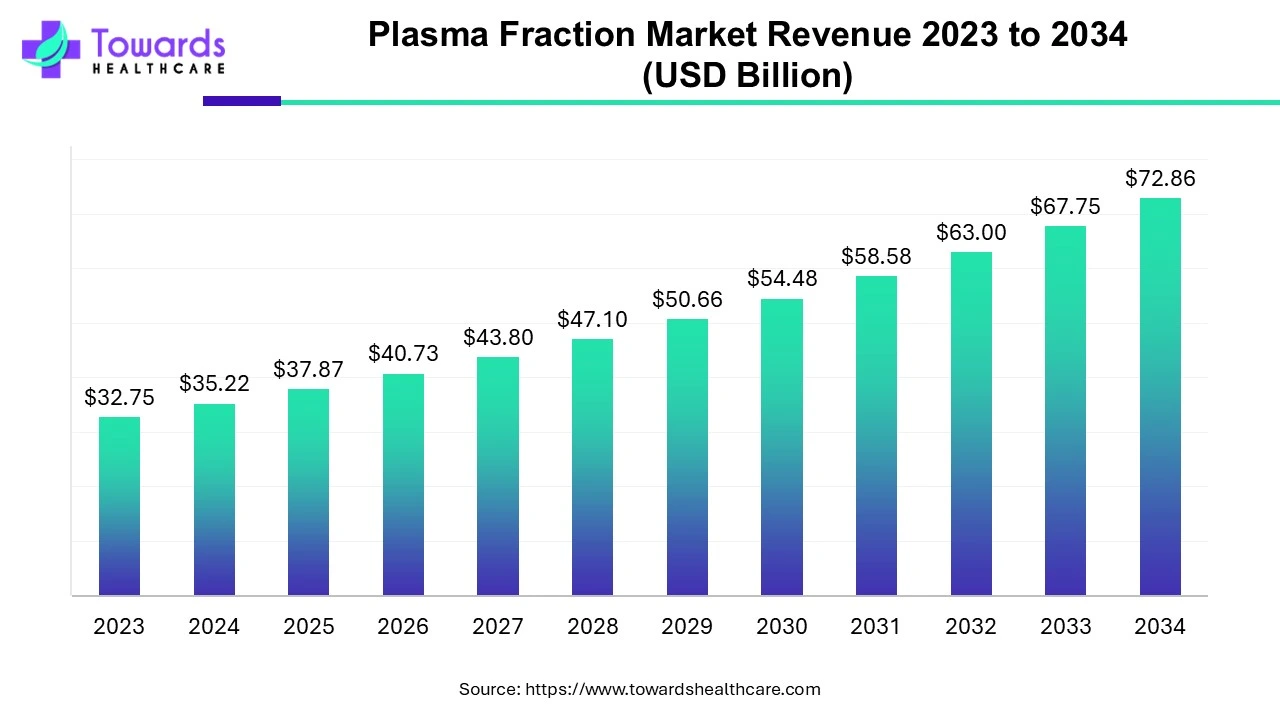Plasma Fractionation Market Growth, Trends and Regional Insights
The global plasma fractionation market was valued at approximately US$ 32.75 billion in 2023 and is expected to expand to US$ 72.86 billion by 2034, growing at a compound annual growth rate (CAGR) of 7.54% from 2024 to 2034. This growth is driven by an increasing demand for plasma-derived medicines, which are used to treat conditions such as rabies, tetanus, shock, and trauma. As a result, the plasma fractionation market is experiencing significant growth worldwide.

Download statistics of this report @ https://www.towardshealthcare.com/download-statistics/5304
What is Plasma Fractionation?
Plasma fractionation is a complex separation process that extracts various protein components from human blood plasma. This procedure plays a crucial role in pharmaceutical research and in the development of advanced fractionation technologies. Plasma, a key component of human blood, is composed of water (91.5%), proteins (7%), and salts (1.5%). The protein content includes essential proteins such as albumin (54%), immunoglobulin (38%), and fibrinogen (7%).
This process is vital in the production of medicines that are used to treat various diseases, including immunodeficiencies, genetic disorders, rabies, tetanus, shock, and trauma. As the prevalence of these global health conditions continues to rise, the demand for plasma-derived medicines has surged, driving the expansion of the plasma fractionation market.
Growth and Scope of the Plasma Fraction Market
The scope of plasma fractionation has greatly expanded in recent years, particularly in the healthcare industry and the development of therapeutics and biologics. Currently, over 20 different proteins derived from plasma are being utilized in medical treatments. The growing demand for high-quality plasma-based therapies has led manufacturing companies to scale up production to meet the rising need.
Several factors are fueling the rapid growth of the plasma fractionation market, including the increasing demand for plasma-derived medicines, advancements in fractionation technologies, and the growing recognition of the importance of blood donations, especially in developing countries.
Plasma Fractionation Market Trends
The plasma fractionation market has witnessed significant investments and innovations over the past year. For instance:
- Aegros, a biotech start-up specializing in sustainable plasma products, aimed to raise $20 million in May 2024 with backing from the Queensland government. The funds will support the company’s efforts to increase immunoglobulin yield from plasma, which is crucial for treating a range of diseases.
- Takeda, a multinational biopharmaceutical company based in Japan, invested $230 million in June 2024 to expand its plasma-derived therapy (PDT) production capabilities at its facility in Los Angeles, California. This investment is set to enhance the company’s ability to meet the growing demand for plasma-derived medicines.
Key Factors Driving Plasma Fraction Market Growth
Several factors contribute to the robust growth of the plasma fractionation market:
- Rising Prevalence of Hematological Disorders: Plasma fractionation products are essential for treating a wide array of hematological disorders. With the increasing number of individuals affected by these conditions, the demand for blood plasma and related products is growing.
- Growing Awareness for Blood Donations: Awareness campaigns regarding the importance of blood and plasma donations are gaining momentum, particularly in developing and underdeveloped regions. These efforts are driving more individuals to donate, contributing to a steady supply of plasma for fractionation processes.
- Supportive Government Initiatives: Governments around the world are actively promoting blood and plasma donations through various initiatives. Blood donation camps, awareness programs, and new regulations designed to encourage donations are playing a significant role in meeting the increasing demand for plasma products.
The Role of Artificial Intelligence (AI) in Plasma Fractionation
Artificial intelligence (AI) and automation are poised to revolutionize the plasma fractionation process. By integrating AI into fractionation workflows, companies can streamline operations, reduce human error, and lower operational costs. The ability to automate various stages of the fractionation process also enhances efficiency, accuracy, and consistency.
AI can also aid in overcoming some of the challenges associated with plasma fractionation. For instance, isolating specific plasma components can be a difficult and time-consuming task using traditional methods. With AI-powered technologies, this process can be simplified, resulting in more effective fractionation.
Additionally, AI can assist in the long-term storage of plasma components. Automated storage systems powered by AI can maintain the integrity of plasma components, ensuring they remain usable for extended periods, which is essential for therapeutic applications.
Our Table of Content (TOC) covers key healthcare market segments, materials, technologies and trends—helping you navigate market shifts and make informed decisions: https://www.towardshealthcare.com/table-of-content/plasma-fraction-market-sizing
Access exclusive insight now @ https://www.towardshealthcare.com/price/5304
We’ve prepared a service to support you. Please feel free to contact us at sales@towardshealthcare.com
Web: https://www.towardshealthcare.com
Visit Dental Specifics: https://www.towardsdental.com
Get the latest insights on industry segmentation with our Annual Membership: Get a Subscription
For Latest Update Follow Us: https://www.linkedin.com/company/towards-healthcare



